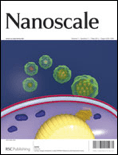
Nanoscale
Scope & Guideline
Connecting Global Minds in Nanoscience.
Introduction
Aims and Scopes
- Nanomaterials Synthesis and Characterization:
The journal publishes research on various synthesis techniques for nanomaterials, including chemical vapor deposition, sol-gel methods, and electrochemical approaches, along with advanced characterization techniques such as microscopy, spectroscopy, and diffraction methods. - Nanoelectronics and Photonics:
Research in this area focuses on the development of nanoscale electronic and photonic devices, exploring new materials, device architectures, and functionalities that leverage nanoscale effects for improved performance in applications such as sensors, transistors, and light-emitting devices. - Biomedical Applications of Nanotechnology:
Nanoscale research is prominently featured in the context of drug delivery systems, imaging agents, and therapeutic applications, emphasizing the design of nanomaterials for targeted delivery and enhanced therapeutic efficacy. - Environmental and Energy Applications:
The journal also covers the application of nanomaterials in environmental remediation, energy storage, and conversion technologies, including solar cells, batteries, and photocatalysis, highlighting their roles in sustainable development. - Nanocomposites and Hybrid Materials:
Research on the integration of nanomaterials into composite systems, aiming to enhance mechanical, thermal, and electrical properties for a range of applications from construction materials to flexible electronics. - Fundamental Studies on Nanoscale Phenomena:
The journal emphasizes theoretical and experimental investigations into nanoscale phenomena, providing insights into quantum effects, surface interactions, and material properties that are unique to nanoscale systems.
Trending and Emerging
- Smart Nanomaterials and Responsive Systems:
Research is increasingly focusing on smart nanomaterials that can respond to environmental stimuli, such as temperature, pH, or light, for applications in drug delivery, sensors, and actuators. - Nanotechnology in Energy Storage and Conversion:
Emerging studies on nanostructured materials for energy applications, especially in batteries and supercapacitors, highlight the trend towards enhancing energy efficiency and sustainability. - Nanoplatforms for Cancer Therapy:
The development of multifunctional nanoplatforms that combine imaging, drug delivery, and therapy, particularly for cancer treatment, is rapidly gaining traction, reflecting the intersection of nanotechnology and biomedicine. - 2D Materials and Heterostructures:
There is a growing body of research on two-dimensional materials, such as graphene and transition metal dichalcogenides, often in heterostructured forms, for applications in electronics, photonics, and sensing. - Quantum Dot Technologies:
Advancements in quantum dot synthesis and their application in optoelectronics, including light-emitting diodes and solar cells, signify a trend towards utilizing nanoscale properties for enhanced device performance. - Machine Learning in Nanotechnology:
The integration of machine learning and artificial intelligence with nanotechnology research is on the rise, facilitating the discovery of new materials and optimization of nanomaterial properties.
Declining or Waning
- Traditional Nanoparticle Applications:
Research focused on conventional applications of nanoparticles, such as in cosmetics or basic catalysts, has become less prominent compared to more complex systems that integrate multiple functionalities or advanced delivery mechanisms. - Basic Materials Characterization:
There is a noticeable decrease in publications that solely focus on basic characterization techniques without significant advancements or applications, as the field moves towards more application-driven research. - Standard Nanomaterials without Functionalization:
Research centered around unmodified or standard nanomaterials has waned as the emphasis shifts towards functionalized and hybrid materials that offer enhanced properties or specific applications. - Non-specific Drug Delivery Systems:
The decline in interest in non-targeted drug delivery systems reflects a broader trend towards precision medicine and targeted therapies, where specificity and efficacy are paramount. - Bulk Nanomaterials:
There has been a reduction in studies focusing on bulk nanomaterials as the community increasingly prioritizes nanoscale interactions and properties that deviate from bulk behavior.
Similar Journals
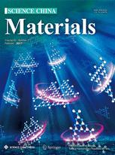
Science China-Materials
Unveiling Breakthroughs in Material Development.Science China-Materials is an esteemed peer-reviewed journal dedicated to advancing the field of materials science, published by SCIENCE PRESS. With a strong focus on innovative research and applications, this journal provides an essential platform for disseminating groundbreaking findings in materials development, characterization, and engineering. Since its inception, Science China-Materials has achieved an impressive Q1 ranking in the Materials Science (miscellaneous) category, reflecting its commitment to quality and the impact of its publications, as indicated by its 86th percentile ranking in Scopus. The journal is set to converge its contributions from 2016 to 2024, making it a vital resource for researchers and professionals interested in the latest advancements and trends in materials science. As an open access publication, it ensures that knowledge is freely available to a global audience, promoting collaboration and innovation across disciplines. The journal is headquartered in Beijing, China, and continues to attract high-quality submissions from leading experts in the field.

Discover Nano
Connecting Ideas, Shaping the Future of NanoscienceDiscover Nano is a pioneering journal published by SPRINGER, dedicated to the rapidly evolving field of nanoscience and nanotechnology. Established in 2023, this innovative platform provides an open-access forum for researchers, professionals, and students to share and disseminate cutting-edge findings in materials science and condensed matter physics. With its commitment to accessibility, Discover Nano encourages a broad spectrum of contributions, aiming to foster collaboration and stimulate discussion in this dynamic area of study. As a new entry into the academic community, the journal holds great potential for growth, aspiring to increase its visibility and impact in the materials science arena, where it currently ranks in the bottom quartile for both materials science and physics categories. Based in Germany and reaching a global audience, Discover Nano represents a significant opportunity for those looking to shape the future of nanotechnology through impactful research and interdisciplinary dialogue.

JOURNAL OF MATERIALS SCIENCE-MATERIALS IN ELECTRONICS
Pioneering Discoveries at the Intersection of Materials and ElectronicsJOURNAL OF MATERIALS SCIENCE-MATERIALS IN ELECTRONICS, published by Springer, is a distinguished international journal that serves as a vital platform for the dissemination of cutting-edge research in the field of materials science, with a keen focus on electronics. Since its inception in 1990, this journal has consistently contributed to the advancement of knowledge across a range of interdisciplinary categories, including Atomic and Molecular Physics, Optical and Magnetic Materials, and Biomedical Engineering, achieving notable quartile positions in various 2023 Scopus rankings. With an impact factor that signifies its scholarly influence, this journal provides a rigorous peer-reviewed environment for researchers and practitioners to share innovative ideas, experimental findings, and theoretical developments. Although it does not currently offer open access options, the depth and breadth of topics covered—including condensed matter physics and bioengineering—make it an essential resource for those at the forefront of materials research. With a commitment to bridging the gap between theory and practical application, the JOURNAL OF MATERIALS SCIENCE-MATERIALS IN ELECTRONICS continues to pave the way for future explorations in the ever-evolving landscape of materials science.
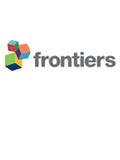
Frontiers in Materials
Driving Progress with Open Access Research.Frontiers in Materials, an esteemed journal published by FRONTIERS MEDIA SA, is a leading platform in the field of Materials Science, with a notable impact factor placing it in the Q2 category of its discipline as of 2023. Since its establishment as an Open Access journal in 2014, it has fostered considerable academic exchange, allowing researchers from around the globe to share their innovative findings and insights. Based in Lausanne, Switzerland, this journal not only emphasizes high-quality peer-reviewed articles but also prioritizes rapid dissemination of research, as evidenced by its commendable Scopus ranking of #62 out of 196 in Materials Science (miscellaneous). By consistently striving to bridge the gap between academia and practical applications, Frontiers in Materials serves as an invaluable resource for researchers, professionals, and students seeking to delve into cutting-edge advancements and transformative applications in materials science.

Journal of Nanoanalysis
Empowering Innovation in NanoanalysisThe Journal of Nanoanalysis is a leading publication in the field of nanotechnology, dedicated to advancing the understanding and application of nanoscale analysis methodologies. Published by BORNA SANJESH KIMIA CO-BSK CO, this journal aims to provide a comprehensive platform for researchers, professionals, and students to disseminate cutting-edge findings and innovative approaches in nanomaterials characterization, nanoelectronics, and related areas. With a focus on high-quality peer-reviewed articles, the journal supports the global scientific community in fostering interdisciplinary collaboration and knowledge sharing. Although currently lacking an explicit impact factor, the Journal of Nanoanalysis is poised to make significant contributions to the field, with its commitment to open access and accessibility globally enriching the pool of research available for academic and practical advancements.

ADVANCED FUNCTIONAL MATERIALS
Transforming Ideas into Advanced Functional SolutionsADVANCED FUNCTIONAL MATERIALS is a leading journal published by WILEY-V C H VERLAG GMBH, prominently recognized in the fields of biomaterials, chemistry, condensed matter physics, and materials science. With an impressive impact factor and a distinguished position in the Q1 quartile across multiple categories including nanoscience and nanotechnology, this journal serves as a vital platform for researchers and professionals committed to innovating in functional materials. Since its inception in 2000, ADVANCED FUNCTIONAL MATERIALS has published high-quality peer-reviewed articles that push the boundaries of materials science, exploring new frontiers in electronic, optical, and magnetic materials. The journal's dedication to open access ensures that its groundbreaking findings are readily available to a global audience, fostering collaboration and knowledge-sharing among scholars and practitioners in the field. For those seeking to stay at the forefront of materials research, ADVANCED FUNCTIONAL MATERIALS is an essential resource.

Journal of Nanoelectronics and Optoelectronics
Advancing Knowledge in Nanoscale ElectronicsJournal of Nanoelectronics and Optoelectronics is a premier peer-reviewed journal published by AMER SCIENTIFIC PUBLISHERS that showcases cutting-edge research in the fields of electrical engineering, nanoelectronics, and optoelectronic materials. Established in 2006 and spanning through to 2017, this journal provides a platform for scientists and engineers to share their latest findings, developments, and innovations. Although coverage has been discontinued in Scopus, it retains an regional impact within its field, ranking #388 out of 654 in Electrical and Electronic Engineering and #156 out of 219 in Electronic, Optical, and Magnetic Materials. The journal is crucial for those seeking to advance their knowledge in nanoscale electronic components and optoelectronic devices, making it an essential resource for researchers, professionals, and students committed to this dynamic area of study. While the journal is not open access, it remains a significant contributor to the scholarly discourse surrounding next-generation electronic technologies and materials.

MRS Advances
Unveiling Breakthroughs in Mechanical EngineeringMRS Advances, published by Springer Heidelberg, is an esteemed academic journal that serves as a vital platform for disseminating cutting-edge research in the fields of condensed matter physics, materials science, and mechanical engineering. With an ISSN of 2731-5894 and an E-ISSN of 2059-8521, the journal is hosted in Switzerland and encompasses an impressive spectrum of innovative studies that impact both theoretical and practical applications. Throughout its converged years from 2012 and continuing through 2024, MRS Advances has established itself with notable rankings, including Q4 in condensed matter physics and Q3 in several related categories. This journal not only enriches the academic community with its rigorous peer-reviewed articles, but also encourages open discussions that further advance research innovations. Although currently not designated as an open-access journal, its accessibility through institutional subscriptions ensures that professionals, researchers, and students can engage with the latest advancements in the material science arena. Emphasizing its relevance, MRS Advances is dedicated to fostering interdisciplinary collaboration and inspiring new discoveries within the global research community.
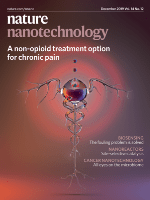
Nature Nanotechnology
Unleashing Potential through Nanotechnology.Nature Nanotechnology, published by NATURE PORTFOLIO, stands at the forefront of scientific innovation, focusing on the rapidly evolving field of nanoscience and nanotechnology. With an impressive impact factor and ranking in the top Q1 quartiles across multiple disciplines—including Atomic and Molecular Physics, Bioengineering, and Materials Science—this journal is a pivotal resource for researchers and professionals dedicated to advancing knowledge and applications at the nanoscale. Its diverse scope encompasses cutting-edge research that bridges disciplines, addressing critical challenges in engineering, physics, and biomedical fields. Although the journal currently does not offer an open-access option, readers can access a wealth of information that is vital for anyone involved in pioneering research and development efforts. With its robust editorial standards and a commitment to publishing high-caliber, groundbreaking work, Nature Nanotechnology serves as an indispensable platform for the dissemination of transformative ideas that will shape the future of technology and science.
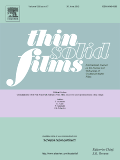
Thin Solid Films
Exploring the Frontiers of Thin Film TechnologyThin Solid Films, published by ELSEVIER SCIENCE SA, is a highly regarded journal in the fields of materials science and physics, specifically focused on the properties and applications of thin films. Established in 1967, this journal has been a leading platform for disseminating research on surfaces, coatings, and advanced materials. With its consistent publication through the notable HIndex of scholarly impact, this journal showcases a diverse range of studies ranging from electronic, optical, and magnetic materials to novel surface and interface engineering. In recent evaluations, Thin Solid Films has achieved significant rankings, including a Q2 position in Materials Chemistry and Metals and Alloys, reflecting its relevance and importance in ongoing scientific discourse. Although it does not offer open access, it provides a vital resource for researchers, professionals, and students seeking to advance their knowledge and expertise in thin film technology. The journal's commitment to quality and innovation makes it an essential publication for anyone engaged in the field.